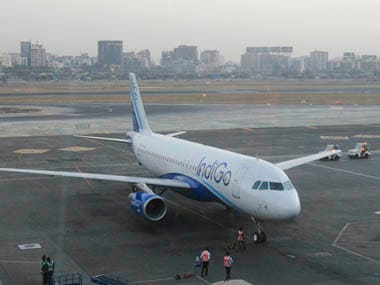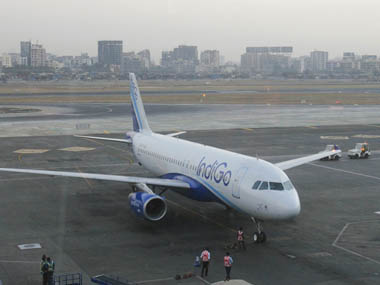With the fresh order of 250 Airbus 320Neos, IndiGo has changed the game for all other airlines operating in India. In fact, its mega aircraft order shows not just immense confidence in the Indian growth story but also in its own ability to inch ahead of other airlines, whether they are low cost competitors or legacy carriers. Can competitors disrupt the IndiGo fairy tale growth? IndiGo is following in the footsteps of aviation industry upstarts like Etihad Airways and its other Gulf cousins - airlines which are taking competition to the doorstep of powerful American and European carriers by massive fleet expansion and aggressive wooing of the global traveller. Rapid and ambitious fleet expansion is the key to this aggression. Can domestic competitors to IndiGo rise to the challenge, given their weak balance sheets and continuing financial woes?[caption id=“attachment_2333124” align=“alignleft” width=“380”]  An IndiGo aircraft. Reuters[/caption] Bombarding the Indian market with capacity is a game IndiGo has long been adept at. It is already a market leader by a comfortable margin with its fleet of 97 operational aircraft and accounts for 40 percent of the domestic market in terms of passengers. Its victory is sweeter since it operates just about a fourth of the total aircraft in the Indian market but has managed to corner more than a third of all domestic passengers. Global aviation consultancy CAPA has estimated IndiGo’s market share will reach 50 percent by next year. Lets look at the order book of all airlines in India and their publicly known fleet plans. IndiGo has 97 operational aircraft, 180 more already ordered for which deliveries begin later this year and then these 250 aircraft which start coming in by 2018. Till 2026 or roughly in the next decade, some of the total 530 odd aircraft would be used as replacements. How many that will be we know not but it is fair to assume that within the next 10 years, IndiGo’s fleet alone may well be the size of the combined fleet size of all airlines operating in India at present. SpiceJet, the second largest airline by passengers, has a fleet of 18 Boeing 737s and 14 Q400 aircraft as per information available on the airline’s own website. It has 42 Boeing 737Max planes on order and claims to have begun negotiations for another 100 aircraft with both, Airbus and Boeing. Clearly, even if this 100 aircraft order is finalised and deliveries begin over the next few years, SpiceJet’s fleet plans are no where near IndiGo’s ambitious ones. If fleet size is no match, is it reasonable to assume that competitive intensity will also reduce vis-a-vis the market leader going forward? GoAir has 72 Airbus 320neos on order which begin coming in by 2016 and continue till 2020. Its present fleet is just 19 aircraft. So even after the deliveries of the 72 aircraft are completed, Go Air is unlikely to be a serious threat to IndiGo in the near future. Now lets look at the new kid on the block, AirAsia India. It has a fleet of five aircraft now but is going slow on further expansion due to several policy hurdles. It had initially planned to lease 10 aircraft by end of this year. The two legacy carriers, Air India and Jet Airways, have larger fleets compared to IndiGo at present but the fleets are a mix of wide bodies, narrow bodies and regional jets while IndiGo’s aircraft are all narrow bodies. Air India has a fleet of 115 aircraft as per its website, which include 43 wide body planes and 10 regional aircraft besides 62 narrow bodies. Jet Airways has a fleet of 116 aircraft and has said earlier it plans to augment this number only by 2017-18. Lets look at why IndiGo is so confident of the Indian market potential. The airline has already announced its intention to mop up close to Rs 2,500 crore through a maiden public offering later this year. Remember, only Jet Airways and SpiceJet are publicly listed companies as of now and the only other listed airline - Kingfisher Airways - had to shut down. IndiGo certainly needs the money - it says some will be deployed in buying out about five aircraft which are currently on lease and remaining funds will be used for getting some ground handling equipment etc. Analysts have been wondering whether this aircraft order has come now, just ahead of the IPO, to boost investor confidence. Whatever be IndiGo’s reasons for announcing the aircraft order now, it seems confident enough of not only being able to service this $26.55 billion purchase through various financing options but also of its ability to outclass rivals.
IndiGo is following in the footsteps of aviation industry upstarts like Etihad Airways and its other Gulf cousins.
Advertisement
End of Article


)

)
)
)
)
)
)
)
)



